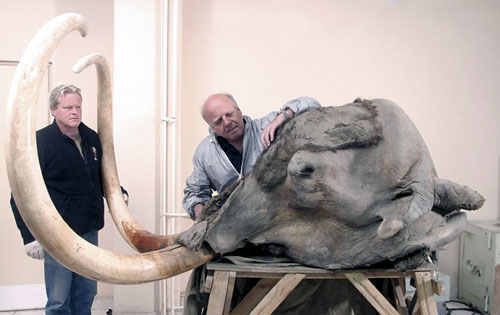 Woolly mammoth genome comes
to life
Woolly mammoth genome comes
to life
Decoding extinct genomes now
possible, says geneticist
December 27, 2005
Tuesday
History has been made by mapping a portion of the woolly mammoth's
genome by a McMaster University geneticist, in collaboration
with genome researchers from Penn State University and the American
Museum of Natural History. The discovery, which has astounded
the scientific world, surpasses an earlier study released recently
by Nature that also concerns the woolly mammoth.
Hendrik Poinar, a molecular
evolutionary geneticist in the department of anthropology and
pathology at McMaster University, says his study involves the
vital nuclear DNA within a Mammoth rather than the lesser mitochondria,
on which the Nature study is based.
 Hendrik Poinar, a geneticist
with McMaster University in Hamilton, Ontario, has succesfully
sequenced a portion of the genome from a woolly mammoth. Poinar
is pictured with the remains of Dima, a baby woolly mammoth unearthed
in 1977.
Hendrik Poinar, a geneticist
with McMaster University in Hamilton, Ontario, has succesfully
sequenced a portion of the genome from a woolly mammoth. Poinar
is pictured with the remains of Dima, a baby woolly mammoth unearthed
in 1977.
Photo credit: D. Poinar
"Mitochondria is so 1980s. It only allows you to look at
the maternal side of evolution," says Poinar. "The
nuclear DNA we've mapped gives us our first glimpse at both sides
of evolution. We can sequence Neanderthals, animals, plants.
Basically, if we find a well-preserved specimen, we can sequence
its genome."
The discovery occurred when
Poinar extracted DNA from a well-preserved Mammoth specimen found
in the Siberian permafrost, and sent it to his research colleagues
at Penn State, who had just taken possession of the latest technology
in genome sequencing. Within hours, his colleagues reported that
the machine had sequenced 30 million base pairs, about one percent
of the entire Mammoth genome. At this rate, it will take a year
to map the entire genome, says Poinar. Funding is currently being
sought for the completion of this project.
 Dick Mol, a paleontologist
in Holland, and Bernard Buigues, curator of the Mammoth Museum
in Siberia, examine the remains of a woolly mammoth. An international
team of researcher, led by Hendrik Poinar of McMaster University
in Hamilton, Ontario, have successfully sequenced a portion of
the genome of an extinct species.
Dick Mol, a paleontologist
in Holland, and Bernard Buigues, curator of the Mammoth Museum
in Siberia, examine the remains of a woolly mammoth. An international
team of researcher, led by Hendrik Poinar of McMaster University
in Hamilton, Ontario, have successfully sequenced a portion of
the genome of an extinct species.
Photo credit: A. Tikhonov
"We were stunned," says Poinar. "We immediately
understood the magnitude of this discovery. Once you successfully
sequence a genome, there are a million interesting questions
one can begin to address. To acquire the genome of an extinct
species is a rare feat. With this level of genetic data we can
begin to look at genes to determine what makes a Mammoth a Mammoth.
We can finally understand the subtle differences between a Mammoth
and its closest living relative, the Indian elephant, but more
importantly our discovery means that recreating extinct hybrid
animals is theoretically possible."
Woolly mammoths, which have
become symbols of the Ice Age, died out 10,000 years ago.
"Naturally there are ethical
issues that come with a discovery of this magnitude, and McMaster
is already planning the first conference devoted to the ethics
of bringing extinct organisms back to life," said Mamdouh
Shoukri, vice-president research and international affairs. "We
have an obligation as scientists to explore and maintain the
responsible use of research."
The study, published last week
in Science, was funded by McMaster University, the Natural Sciences
and Engineering Research Council of Canada, and Penn State University.
McMaster University is a world-renowned,
research-intensive university. It is one of only four Canadian
universities to be listed on the Top 100 universities in the
world. McMaster University has a student population of more than
23,000, and an alumni population of more than 115,000 in 128
countries.
Publish A Letter on SitNews Read Letters/Opinions
Submit
A Letter to the Editor
SitNews
Stories In The News
Ketchikan, Alaska
|


